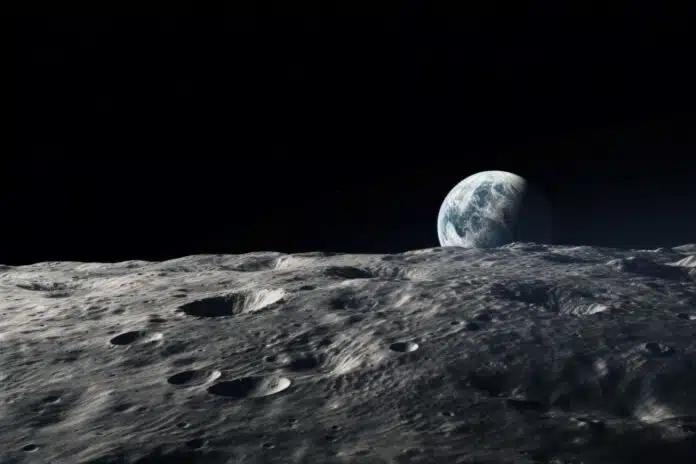
By Pranjal Mehar 5 Aug, 2024
Collected at: https://www.techexplorist.com/primary-process-formed-moon-atmosphere/86873/
Because of space weathering, the Moon has a tenuous atmosphere called an exosphere. The short-lived atoms around the Moon are constantly replenished from lunar soil by processes like micrometeorite impacts, ion sputtering, and photon-stimulated desorption. However, even with recent advances, previous space missions and remote sensing data still need to determine how much each of these processes contributes clearly.
MIT and the University of Chicago scientists have identified the primary process that formed the Moon’s atmosphere and continues to sustain it today. Using high-precision potassium and rubidium isotopic analyses of lunar soils’ samples from the Apollo missions, their study sheds light on the exosphere’s evolution over billions of years.
Their study suggests that the lunar atmosphere is primarily a product of “impact vaporization.”
Based on the analysis of samples of lunar soil collected by astronauts during NASA’s Apollo missions, scientists found that the Moon’s surface has been continuously bombarded, first by massive meteorites, then more recently, by smaller, dust-sized ‘micrometeoroids.’
Such continuous impacts evoke the lunar soil, vaporizing certain atoms on contact and lofting the particles into the air. As a result, some atoms are emitted into space, whereas others remain suspended over the Moon, forming a tenuous atmosphere that is constantly replenished as meteorites continue to pelt the surface.
The study’s lead author, Nicole Nie, an assistant professor in MIT’s Department of Earth, Atmospheric, and Planetary Sciences, said, “We give a definitive answer that meteorite impact vaporization is the dominant process that creates the lunar atmosphere. The Moon is close to 4.5 billion years old, and meteorites have continuously bombarded the surface. We show that eventually, a thin atmosphere reaches a steady state because it’s being continuously replenished by small impacts all over the Moon.”
The Lunar Atmosphere and Dust Environment Explorer (LADEE, pronounced like “laddie”) was a NASA lunar exploration and technology demonstration mission sent in 2013. It discovered an increase in exosphere dust that peaks over the area of the Moon where most micrometeoroids are raining down.
According to scientists, two processes play critical roles in shaping the lunar atmosphere: impact vaporization and “ion sputtering” — a phenomenon involving solar wind, which carries energetic charged particles from the sun through space.
After hitting the Moon’s surface, the particles transfer their energy to the atoms in the soil, sending those atoms sputtering and flying into the air.
“Based on LADEE’s data, it seemed both processes are playing a role,” Nie says. “For instance, it showed that during meteorite showers, you see more atoms in the atmosphere, meaning impacts have an effect. But it also showed that when the Moon is shielded from the sun, such as during an eclipse, there are also changes in the atmosphere’s atoms, meaning the sun also has an impact. So, the results were not clear or quantitative.”
To pinpoint more precisely, scientists examined 10 lunar soil samples, each measuring about 100 milligrams. They then isolated two elements from each sample: potassium and rubidium.
Both elements are volatile, which means impacts and ion sputtering vaporize them.
If the Moon’s atmosphere is made of atoms that have been vaporized and suspended, lighter isotopes would be more likely to stay in the atmosphere, while heavier ones would settle back into the soil. Scientists predicted that impact vaporization and ion sputtering would create different isotopic patterns in the soil. The specific ratio of light to heavy isotopes that remain in the soil, for both potassium and rubidium, should then reveal the primary process contributing to the lunar atmosphere’s origins.
Keeping that in mind, scientists analyzed samples: They crushed the soils into a fine powder and then dissolved them in acids to purify and isolate solutions containing potassium and rubidium. These solutions were then passed through a mass spectrometer, which measured various isotopes of both potassium and rubidium in each sample.
As a result, scientists found that the soils contained mostly heavy isotopes of potassium and rubidium. When they quantified the ratio of heavy to light isotopes of both potassium and rubidium and compared both elements, they found that impact vaporization was most likely the dominant process by which atoms were vaporized and lofted to form the Moon’s atmosphere.
“With impact vaporization, most of the atoms would stay in the lunar atmosphere, whereas with ion sputtering, many atoms would be ejected into space,” Nie says. “From our study, we now can quantify the role of both processes, to say that the relative contribution of impact vaporization versus ion sputtering is about 70:30 or larger.”
In other words, 70 percent or more of the Moon’s atmosphere is a product of meteorite impacts, whereas the remaining 30 percent is a consequence of the solar wind.
“The discovery of such a subtle effect is remarkable, thanks to the innovative idea of combining potassium and rubidium isotope measurements along with careful, quantitative modeling,” says Justin Hu, a postdoc who studies lunar soils at Cambridge University, who was not involved in the study. “This discovery goes beyond understanding the moon’s history, as such processes could occur and might be more significant on other moons and asteroids, which are the focus of many planned return missions.”
Journal Reference:
- Nie, N. X., Dauphas, N., Zhang, Z. J., Hopp, T., & Sarantos, M. (2024). Lunar soil record of atmosphere loss over eons. Science Advances. DOI: 10.1126/sciadv.adm7074

Leave a Reply